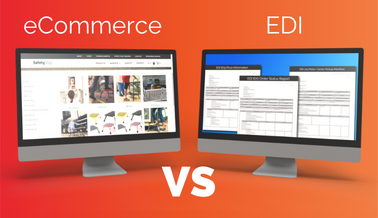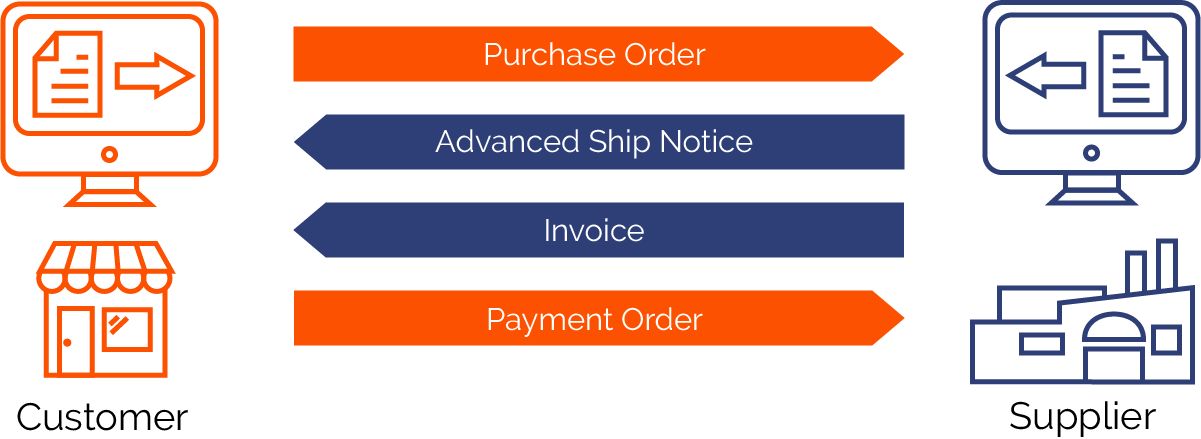How EDI and eCommerce Work Together

June 9, 2022
According to Digital Commerce 360, electronic data interchange (EDI) facilitated 76.5% of digital B2B sales in 2021. That’s huge, and it means many people are taking advantage of system-to-system automation in ordering and fulfillment. In comparison, dedicated B2B eCommerce channels account for 12.5% of digital sales in 2021. While that’s a smaller portion of the pie, eCommerce grew twice as fast as EDI year-over-year.
In fact, you don’t have to choose between eCommerce and EDI. Manufacturers, wholesalers, and distributors can all benefit from employing integrated EDI and eCommerce strategies to save time and money. EDI and eCommerce can both replace manual systems with automated processes, but they each have different applications. Integrated EDI connects your channels directly to your business systems to automate ordering, fulfilment, accounting, and more. On the other hand, eCommerce platforms showcase your catalog, attract new customers, and offer a B2C-like shopping experience, allowing sellers to influence buyer behavior.
Let’s take a look at how these strategies can complement one another.
eCommerce Vs. EDI: What Are the Differences?
B2B eCommerce and EDI solutions both allow you to accept orders electronically and streamline manual processes. That said, they don’t perform the exact same functions. Knowing what each approach offers is essential to getting the most value out of both.
What is B2B eCommerce?

On a basic level, a B2B eCommerce platform allows your customers to view your products and make purchases online. The mechanics resemble B2C eCommerce platforms like Shopify, WooCommerce, or Amazon, although typically B2B platforms are restricted to verified trading partners.
So, how does a B2B eCommerce system work? Typically, customers will interact with your business through an online storefront where they can set up an account and view items you have in stock. B2B eCommerce platforms like TrueCommerce allow users to compare products side-by-side, reach out to sales staff if they need help, create shopping carts, select shipping options, and check out. And while it might look like B2C eCommerce sites, the solution also includes B2B-specific features like customer segmentation, volume pricing, and multiple-ship-to support.
Advantages of B2B eCommerce
Using a B2B eCommerce strategy opens many doors. Your business can execute orders faster since customers can simply log in and place orders themselves. While they shop around, intelligent eCommerce systems suggest related products and buy-it-again items. And SEO-optimized product pages can attract new customers as they browse the web. Here are a few main benefits of a B2B eCommerce platform:
- Speed: A self-service online ordering system allows customers to make purchases when they want, and the system sends order information directly to your ERP.
- Upsell and cross-sell: The platform can suggest upsells and related items as customers shop.
- Customer interaction: Sales staff can interact with customers before they purchase and answer questions.
- Product catalog: Customers can see all your available products and compare features right on the platform.
- Reach new customers: Product pages optimized for search engines can attract new customers on their own.
- Marketing: B2B eCommerce systems can collect customer data to facilitate further marketing through email, direct mail, and more.
Disadvantages of Only Using B2B eCommerce
If you only use an eCommerce platform for B2B sales, you could miss out on deeper levels of automation or even partnerships with major retail outlets. For example:
- Partners with high-volume orders may be better served with EDI instead of B2B eCommerce.
- Some automation is possible with B2B eCommerce systems, but EDI allows direct computer-to-computer ordering based on stock levels.
- Many major retailers require their trading partners to have EDI capabilities. Businesses with an eCommerce-only approach would need to adapt or pass up an opportunity.
Watch an Overview of Our B2B eCommerce Solution
What is EDI?
Electronic Data Interchange, or EDI, is a way of exchanging digital business transactions directly between trading partners (customers, 3PLs, suppliers, carriers, and more). Among the many supported documents are advance ship notices, purchase orders, invoices, and carrier bills of lading. Integrated EDI can provide visibility into an order as it travels from manufacturer to distributor to retailer without requiring any humans for manual data entry.
An EDI platform like TrueCommerce integrates directly with your ERP system to automate the information flowing between your internal systems, fulfillment and warehousing partners, and customers. With EDI, you and your trading partners can send electronic documents like purchase orders in a standard format, automatically.

Advantages of EDI
There’s a reason why three quarters of digital B2B sales in 2021 used EDI. Actually, there are many reasons. System-to-system communication eliminates the need for manual data entry, increases productivity, gives you better visibility into your supply chain, and more:
- Accuracy: An EDI solution eliminates human error from many steps in the supply chain.
- Less busywork: Instead of rekeying order information or typing up documents, your employees can focus on solving more important business challenges.
- Better fulfillment: Orders can be received, packed, verified, and shipped faster with EDI.
- Compliance: Meet the data requirements of large retailers like Walmart.com for speed and accuracy with EDI.
- Automation: An EDI system can automate data transfer with dozens of other business systems like NetSuite, QuickBooks, Oracle, and Sage.
Disadvantages of an EDI-Only Approach
If you only use EDI for B2B sales, you could be missing out on forming relationships with customers who prefer a self-serve online storefront or who aren’t EDI capable. For example:
- EDI doesn’t provide shopping tools for customers to compare products or make up their minds.
- Customers who make irregular purchases or prefer to peruse a digital aisle would be better served with an eCommerce system.
- EDI data is internal and won’t attract people browsing on search engines.
- Not all trading partners have the capability or desire to implement EDI.
When to Use eCommerce and When to Use EDI
Between eCommerce vs EDI, one may make more sense for your business now than the other. But both can present growth opportunities in different dimensions.
Generally speaking, B2B eCommerce is best for:
- Displaying an interactive product catalog to educate buyers
- Offering a self-service buying platform
- Adding value with cross-sells and upsells
On the other hand, EDI is best for:
- Supporting electronic format ordering
- Automating ordering based on real-time stock levels
- Complying with supply chain requirements from major retailers
Both types of systems can integrate with your ERP. However, not all eCommerce or EDI providers offer these types of integrations, so be sure to consider that when evaluating vendors. Both types of systems can also handle repeat ordering and provide customers with shipment tracking information.
The Benefits of EDI and eCommerce Together
If you can, why not pick both? Successful businesses can extract value out of both B2B eCommerce and EDI at the same time. For example, stepstool manufacturer Safety Step was able to reduce B2B order processing time by up to 70% by combining TrueCommerce EDI with their eCommerce platform. The EDI integration allows online order data to flow automatically into Safety Step’s business system and bypass manual entry.
On the other hand, precision metal manufacturer C.E. Smith had used EDI for many years but had dealt with a standalone web store (and the bugs that came with it). The web store did not integrate with the company’s ERP or EDI systems. C.E. Smith’s team decided to try TrueCommerce’s eCommerce platform because it was fully managed for them and could integrate seamlessly with their other business systems. In the end, the switch helped them save money and focus on more high-value work with their time.
Combine EDI and eCommerce for Your Business
B2B eCommerce and EDI make a great pair. While EDI is the norm for many B2B online sales, eCommerce is growing fast. Using EDI and B2B eCommerce strategies means you’ll be able to satisfy diverse trading partners as opportunities arise and reduce your costs at the same time. Reach out today to learn how combining eCommerce and EDI can benefit your business, and how TrueCommerce can connect both to your ERP.
About the Author: Ben Taylor has held a variety of roles on both the vendor and client side under the banner of digital commerce / digital enablement for more than a decade. Currently, he shares his expertise with customers and prospects as Director of Pre Sales, Europe. Ben has deep experience across the procurement, sale and implementation of EDI, master data management, B2B eCommerce and Omnichannel trading solutions, including a wide range of use cases. He’s passionate about identifying and installing digital solutions that deliver tangible commercial benefits and oil the cogs of commerce.
Share this post:
Stay ahead of the competition
Get expert supply chain insights delivered directly to your inbox weekly.
